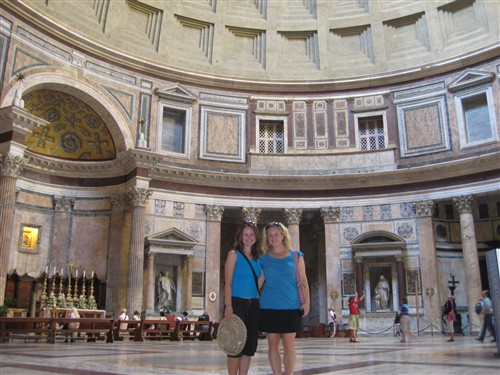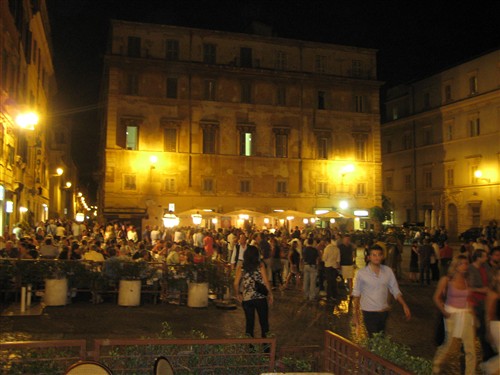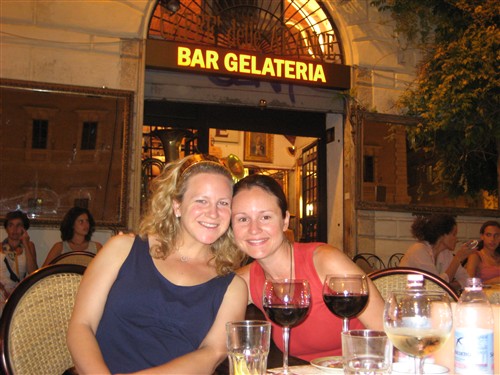Posted under Italy

Between servings of pizza, pasta, caprese salad, and gelato, we managed to fit in a respectable number of sights: Pantheon, Piazza Navona, Campo de’Fiori, Colosseum, Circo Massimo, Villa Borghese, Spanish Steps, Trevi Fountain, Time Elevator, Chiesa di Santa Maria della Concezione, and the neighborhood of Trastavere. We started early both mornings and pounded the pavement until dinner. Like Paris, Barcelona and New York, Rome has so much to see and often the less significant stops are the most rewarding. In the interest of preserving my sanity, as we are already in Tuscany now, I will elaborate only on a few sights that especially moved me.
The Pantheon, dating back to AD 120, is ancient Rome’s best-preserved building. The name Pantheon derives from the Greek words pan (all) and theos (god); the original temple was dedicated to the classical Gods but the Pantheon has been a Christian church for most of its nearly 2000 years in existence. (Lonely Planet, Feb 2008)
 From the outside, it looks nothing like a church and much like a government building. Only after stepping inside do you begin to appreciate its architectural significance. The Pantheon is topped by the largest stone vault ever built – a perfect semisphere, meaning that the diameter (43.4 meters) of the dome is exactly equal to the height. There are no windows. The only natural light enters through a hole at the top of the dome and through the entrance when the tall bronze doors are open. The interior furnishings and embellishment are muted in comparison to other Christian buildings in Rome and elsewhere, with only a few marble sculptures and sparse iconography. Even the altar is decorated simply. The multi-hued stone and the vastness of the dome speak for the Pantheon’s magnificent beauty.
From the outside, it looks nothing like a church and much like a government building. Only after stepping inside do you begin to appreciate its architectural significance. The Pantheon is topped by the largest stone vault ever built – a perfect semisphere, meaning that the diameter (43.4 meters) of the dome is exactly equal to the height. There are no windows. The only natural light enters through a hole at the top of the dome and through the entrance when the tall bronze doors are open. The interior furnishings and embellishment are muted in comparison to other Christian buildings in Rome and elsewhere, with only a few marble sculptures and sparse iconography. Even the altar is decorated simply. The multi-hued stone and the vastness of the dome speak for the Pantheon’s magnificent beauty.
Later in the day, we were happily surprised to discover the breadth of significant artwork at the Borghese Museum & Gallery. It is so popular that you must call ahead to reserve a space in one of several two-hour time slots and, once you enter at the appointed time, you can only stay for two hours. The collection was amassed by Cardinal Scipione Borghese and was later purchased by the Italian state. It includes works by Bernini, Raphael, Botticelli, and Caravaggio to name a few. It is on this visit to Rome that Bernini has transitioned in our minds from a name in a book to one of the most gifted sculptors of all time. I can now identify a Bernini sculpture from across the room, standing out among others for the flawless texture of skin and the motion of his subjects. The most breathtaking example of this in the Borghese Gallery is Bernini’s Rape of Persephone (1621-22) in which Pluto discovers the virginal Persephone alone in a clearing and is so taken with her beauty that he grabs her and whisks her away despite her violent protests. Bernini’s sculpture captures the passionate struggle on the young Persephone’s face and her powerlessness against the virile Pluto. Most amazing, however, is how Bernini carved Pluto’s hand clutching Persephone’s supple young thigh, capturing the perfect indent in her thigh as it yields to his grasp. We lingered around the work, smiling as we watched others gasp and point at the same discovery. Two hours was much too little for the number of masterpieces on display here. We rushed by many works at which I would have liked to linger and if the curator’s aim in imposing such time limits is to leave you wanting more, then he has certainly achieved it.
 Rome is famous for its dreamy piazzas – open squares tucked into the city, often with a central fountain, coming alive on moonlit evenings. The Trevi Fountain – Rome’s most famous – is the focal point of one such piazza. “The baroque bonanza was designed by Nicola Salvi in 1732 and depicts Neptune’s chariot being led by Tritons with sea horses – one wild, one docile – representing the various moods of the sea.” (Lonely Planet, Feb 2008) The piazza was full of people snapping photos, enjoying cones of gelato, or just staring at the Trevi’s mesmerizing dance in its pool of aquamarine.
Rome is famous for its dreamy piazzas – open squares tucked into the city, often with a central fountain, coming alive on moonlit evenings. The Trevi Fountain – Rome’s most famous – is the focal point of one such piazza. “The baroque bonanza was designed by Nicola Salvi in 1732 and depicts Neptune’s chariot being led by Tritons with sea horses – one wild, one docile – representing the various moods of the sea.” (Lonely Planet, Feb 2008) The piazza was full of people snapping photos, enjoying cones of gelato, or just staring at the Trevi’s mesmerizing dance in its pool of aquamarine.
But all of the piazzas are better at night when the soft golden light of the streetlamps take over for the sun and the pretty squares are filled with poshly dressed revelers and couples out for a quiet stroll. The fountains are alight and candles flicker from restaurant patios. We chose the Trastavere neighborhood to have a few drinks out one evening and found ourselves in the exact piazza that I’ve just described. We settled down at a table on the edge of the action and watched the goings on over glasses of big, juicy Cabernet.

On the way home that night, our trio got separated. Italian public buses have a decidedly inconvenient system whereby you cannot pay your fare on the bus itself but rather you must buy bus tickets either in the metro station or in the corner tobacco shops, neither of which seems ever to be near the bus stop. We had however, earlier come across one bus with a machine that took coins for tickets. When our bus number pulled up to our stop, Aaron stepped on to see if that particular bus had a similar coin machine since we didn’t have tickets. The bus driver closed the doors behind him and would not let him off the bus even after he explained the situation. We waved to each other through the window as the bus pulled away. Natty and I hopped onto the next bus with our stop on its itinerary. About five minutes later, our bus stopped, far from our final destination, and everyone disembarked, including the driver. We got off with no idea where we were and no map because Aaron had it in his pocket when he was stolen by the first bus. After some initial confusion, we put our heads together and found our way home. Aaron arrived ten minutes after us, having had a similar experience. It had been a long wonderful night with a little adventure for dessert, and we were all happy to be home.
 The final stop that I want to mention is the Chiesa di Santa Maria della Concezione – a small, nondescript 17th century church near Piazza Barberini. What makes it one of the most fascinating stops on the tourist trail is the crypt which is decorated with the bones of 4,000 departed monks. We knew going in what we were going to see and still our jaws dropped at the sight of it. The crypt consists of five or six small rooms with dirt floors, each with an elaborate and mesmerizing display. Bones are used to make chandeliers, picture frames, flower patterns and a clock, among many other designs. Some of the skeletons are posed intact, dressed in the brown monks’ robes; some of the faces still have traces of flesh which has yet to decompose. The displays are eerily fascinating. Four thousand monks yield a lot of bones! Stacks of hundreds of femurs, tibias and fibulas line the walls in artistic forms. Hip bones become angel wings under smiling skulls. To see a sense of humor in the designs is both shocking and refreshing. In the last room along the hall, the collective epitaph of the monks is written on a small board: “What you are now we used to be; what we are now you will be.”
The final stop that I want to mention is the Chiesa di Santa Maria della Concezione – a small, nondescript 17th century church near Piazza Barberini. What makes it one of the most fascinating stops on the tourist trail is the crypt which is decorated with the bones of 4,000 departed monks. We knew going in what we were going to see and still our jaws dropped at the sight of it. The crypt consists of five or six small rooms with dirt floors, each with an elaborate and mesmerizing display. Bones are used to make chandeliers, picture frames, flower patterns and a clock, among many other designs. Some of the skeletons are posed intact, dressed in the brown monks’ robes; some of the faces still have traces of flesh which has yet to decompose. The displays are eerily fascinating. Four thousand monks yield a lot of bones! Stacks of hundreds of femurs, tibias and fibulas line the walls in artistic forms. Hip bones become angel wings under smiling skulls. To see a sense of humor in the designs is both shocking and refreshing. In the last room along the hall, the collective epitaph of the monks is written on a small board: “What you are now we used to be; what we are now you will be.”
When in Rome, eat inordinate amounts of pizza, pasta, and gelato; walk until the bottoms of your feet feel bruised and you are asleep before your head hits the pillow.
One Response to “When In Rome”

Andrew Leonard on 16 Sep 2008 at 11:40 am #
Have you taken a drink out of any of the fountains yet? The water is bellissimo!!